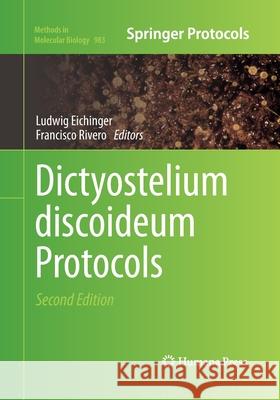Dictyostelium Discoideum Protocols » książka



Dictyostelium Discoideum Protocols
ISBN-13: 9781493959976 / Angielski / Miękka / 2016 / 479 str.
Dictyostelium Discoideum Protocols
ISBN-13: 9781493959976 / Angielski / Miękka / 2016 / 479 str.
(netto: 421,70 VAT: 5%)
Najniższa cena z 30 dni: 424,07
ok. 22 dni roboczych
Bez gwarancji dostawy przed świętami
Darmowa dostawa!
The book offers an introduction to the amoebozoa, presents large-scale analysis methods made possible by the completion of the Dictyostelium genome sequence, and details molecular genetics techniques, cell biological, biochemical and biophysical methods.
1. The Amoebozoa
Christina Schilde and Pauline Schaap
2. The Model Organism Dictyostelium discoideumSalvatore Bozzaro
3. Comparative Genomics of the DictyostelidsWilliam F. Loomis
4. One Stop Shop for Everything Dictyostelium: DictyBase and the Dicty Stock Center in 2012
Petra Fey, Robert J. Dodson, Siddhartha Basu and Rex L. Chisholm
5. Fluorescent Reporters and Methods to Analyze Fluorescent Signals
Annette Müller-Taubenberger and Hellen C. Ishikawa-Ankerhold
6. Collection and Cultivation of Dictyostelids from the Wild
Tracy E. Douglas, Debra A. Brock, Boahemaa Adu-Oppong, David C. Queller and Joan E. Strassmann
7. Identification and Verification of microRNAs by High-throughput Sequencing
Jimmie Hällman, Lotta Avesson, Johan Reimegård, Max Käller and Fredrik Söderbom
8. Transcriptional Profiling of Dictyostelium with RNA Sequencing
Edward Roshan Miranda, Gregor Rot, Marko Toplak, Balaji Santhanam, Tomaz Curk, Gad Shaulskyand Blaz Zupan
9. Analysis of Chromatin Organization by Deep Sequencing Technologies
James L. Platt, Nick A. Kent, Adrian J. Harwood, and Alan R. Kimmel
10. Pharmacogenetics of Resistance to Cisplatin and Other Anti-cancer Drugs and the Role of Sphingolipid Metabolism
Stephen Alexander, William S. Swatson, Hannah Alexander
11. N-glycomic and –Glycoproteomic Studies in the Social Amoebae
Christa L. Feasley, Alba Hykollari, Katharina Paschinger, Iain B. H. Wilson, and Christopher M. West
12. Measuring Cheating, Fitness, and Segregation in D. discoideum
Neil J Buttery, Jeff smith, David C Queller and Joan E Strassmann
13. The Application of the Cre-loxP System for Generating Multiple Knock-Out and Knock-In Targeted Loci
Jan Faix, Joern Linkner, Benjamin Nordholz, James L. Platt, Xin-Hua Liao, and Alan R. Kimmel
14. Extrachromosomal Inducible ExpressionDouwe M. Veltman1 and Peter J.M. Van Haastert2
15. Isolation of Dictyostelium Nuclei for Light and Electron Microscopy
Petros Batsios, Otto Baumann, Ralph Gräf and Irene Meyer
16. Investigation of DNA Repair Pathway Activity
Anne-Marie C. Couto, Nicholas D. Lakin and Catherine J. Pears
17. Transcript Localization in D. discoideum Cells by RNA FISH
Patrick Hofmann, Janis Kruse and Christian Hammann
18. Analysis of Mitochondrial Gene ExpressionJessica E. Accari, Sam Manna, Paul R. Fisher, and Christian Barth
19. Mitochondrial Respiratory Complex Function and the Phenotypic Consequences of DysfunctionSarah J. Annesley, Sergio Carilla-Latorre, Ricardo Escalante and Paul R. Fisher
20. Micropipette Aspiration for Studying Cellular Mechanosensory Responses and Mechanics
Yee-Seir Kee and Douglas N. Robinson
21. Quantitative Analysis of Phagocytosis and Phagosome Maturation
Natascha Sattler, Roger Monroy and Thierry Soldati
22. Setting Up and Monitoring an Infection of Dictyostelium discoideum with Mycobacteria
Sonia Arafah, Sébastien Kicka, Valentin Trofimov, Monica Hagedorn, Nuria Andreu, Siouxsie Wiles, Brian Robertson, and Thierry Soldati
23. Isolation of Pathogen-containing Vacuoles
Olga Shevchuk and Michael Steinert
24. Immuno-magnetic Purification of Fluorescent Legionella-containing Vacuoles
Ivo Finsel, Christine Hoffmann and Hubert Hilbi
25. Secretory Lysosomes in Dictyostelium: Visualization, Characterization and Dynamics
Wanessa C. Lima and Pierre Cosson
26. Monitoring Autophagy in Dictyostelium
Ana Mesquita, Javier Calvo-Garrido, Sergio Carilla-Latorre and Ricardo Escalante
Dictyostelium discoideum is a well-establish eukaryotic model organism that offers unique advantages for studying fundamental cellular processes, including signal transduction, random and directed cell motility, cytokinesis, endocytosis and vesicle transport and development. Dictyostelium is also increasingly used for the investigation of human disease genes and the crosstalk between host and pathogen. The availability of the genome sequence at a mouse click together with a whole range of supporting information and resources along with a powerful armoury of molecular genetics techniques have considerably enhanced the experimental attractiveness of D. discoideum in recent years.
The second edition of Dictyostelium discoideum Protocols incorporates the most recent developments in a number of fields. The book is divided into four parts. The first part provides an introduction to the amoebozoa and community resources. The second part presents large-scale analysis methods made possible by the completion of the Dictyostelium genome sequence. The third part is dedicated to molecular genetics techniques, cell biological, biochemical and biophysical methods. The chapters in the fourth part describe the use of Dictyostelium as a model system to study vesicle formation, trafficking and infection by bacterial pathogens.
Written in the highly successful Methods in Molecular Biology™ series format, chapters include introductions to their respective topics, lists of the necessary materials and reagents, step-by-step, readily reproducible laboratory protocols, and key tips on troubleshooting and avoiding known pitfalls.
Authoritative and practical, Dictyostelium discoideum Protocols, Second Edition seeks to aid scientists in the application of innovating techniques to study a range of fundamental biological processes in this attractive model organism.
1997-2025 DolnySlask.com Agencja Internetowa
KrainaKsiazek.PL - Księgarnia Internetowa









